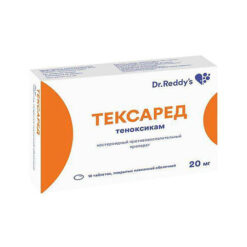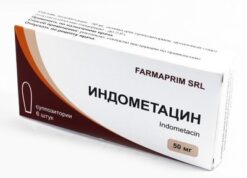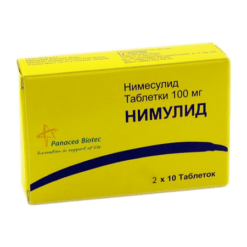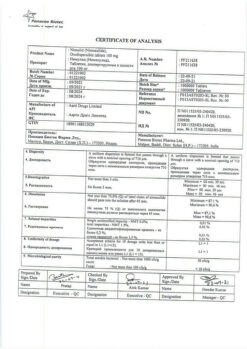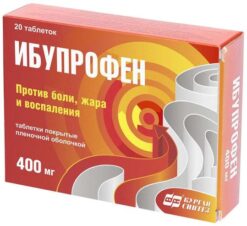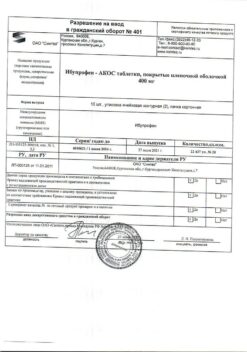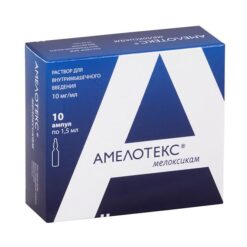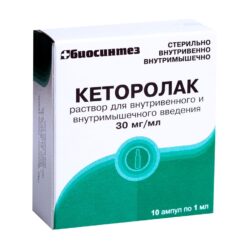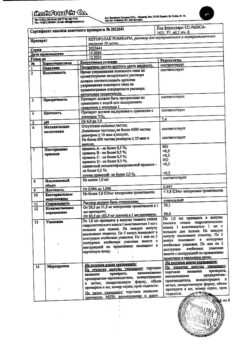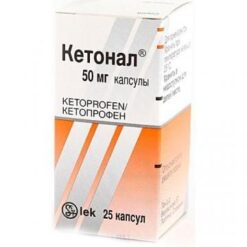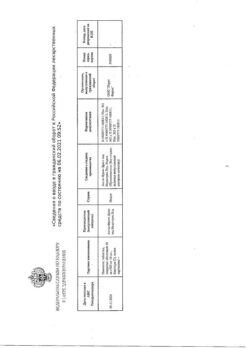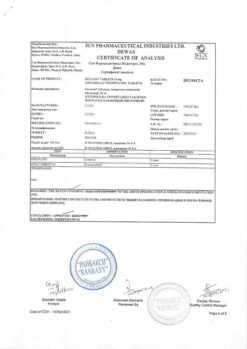No products in the cart.
Texared, lyophilizate 20 mg
€10284.00 €8.57
Description
Tenoxicam, which is a thienothiazine derivative of oxycam, is an NSAID. In addition to its anti-inflammatory, analgesic and antipyretic effects, the drug also inhibits platelet aggregation. Tenoxicam exerts its anti-inflammatory effect by inhibiting the activity of COX isoenzymes involved in arachidonic acid metabolism and thus inhibits the synthesis of PG.
Tenoxicam has no effect on the activity of lipoxygenases. In addition, tenoxicam suppresses some functions of leukocytes, including phagocytosis, histamine release and decreases the content of active radicals in the inflammation focus.
Pharmacokinetics
The drug is rapidly absorbed from the gastrointestinal tract in unchanged form. Cmax is reached 2 hours after drug intake. When the drug is taken after meals or together with antacids, the rate but not the extent of absorption is reduced. The average T1/2 is 70 h. Tenoxicam is fully absorbed, its bioavailability is 100%. In the blood the drug is 99% bound to proteins.
The drug penetrates well into the synovial fluid and is characterized by low systemic clearance and prolonged T1/2, which allows Tenoxicam to be taken once a day.
2/3 of the taken dose of the drug is excreted with urine, 1/3 with feces. There is no cumulation of tenoxicam when prolonged use; serum content of the drug in this case is 10-15 µg/ml.
Indications
Indications
Pain syndrome (mild to moderate intensity): arthralgia, myalgia, neuralgia, migraine, toothache and headache, algodysmenorrhea;
pain in trauma, burns;
inflammatory and degenerative diseases of the musculoskeletal system, accompanied by pain syndrome, such as ischialgia, lumbago, epicondylitis.
It is intended for symptomatic therapy, reduction of pain and inflammation at the time of use, has no effect on the progression of the disease.
Active ingredient
Active ingredient
Composition
Composition
How to take, the dosage
How to take, the dosage
I/m, v/v. Injections of the drug Texared is prescribed for short-term treatment – 20 mg per day; for long-term use – 10 mg per day.
In gouty arthritis, 40 mg per day is prescribed for 1-2 days, in the next 3-5 days – 20 mg per day. The prescribed dose should be used in 1 dose.
Interaction
Interaction
Reduces the effectiveness of uricosuric drugs, increases the effect of anticoagulants, antiaggregants, fibrinolytics, adrenal hormone and GCS side effects and estrogen; reduces the effectiveness of hypotensive drugs and diuretics; increases the hypoglycemic effect of sulfonylurea derivatives.
Enhances blood concentrations of lithium and methotrexate.
The inducers of microsomal oxidation in the liver (phenytoin, ethanol, barbiturates, rifampicin, phenylbutazone, tricyclic antidepressants) increase the production of hydroxylated active metabolites.
Antacids and colestyramine decrease absorption.
Other NSAIDs – risk of side effects, especially gastrointestinal side effects.
Myelotoxic drugs increase the manifestations of hematotoxicity of the drug.
Special Instructions
Special Instructions
During treatment it is necessary to monitor peripheral blood count and functional state of the liver and kidneys, prothrombin index (with indirect anticoagulants), blood glucose concentration (with oral hypoglycemic drugs).
If it is necessary to determine 17-ketosteroids, the drug should be discontinued 48 hours before the study.
A few days before surgical intervention, the drug should be withdrawn.
The possibility of sodium and water retention in the body must be considered when prescribed with diuretics in patients with arterial hypertension and CHF.
To reduce the risk of gastrointestinal adverse events, the lowest effective dose should be used for the shortest possible course.
Impact on the ability to drive and operate machinery. One of the undesirable effects of the drug is dizziness; this should be taken into account in situations requiring the patient’s close attention, such as driving a motor vehicle or operating complex technical devices. During the treatment it is necessary to be cautious while driving vehicles and engaging in other potentially dangerous activities requiring high concentration and quick psychomotor reactions.
Contraindications
Contraindications
Hypersensitivity;
Gastrointestinal erosive and ulcerative lesions (including a history);
Gastrointestinal bleeding (including a history). history);
Heavy gastritis;
The complete or incomplete combination of bronchial asthma, recurrent nasal and paranasal sinus polyposis, and intolerance to acetylsalicylic acid or other NSAIDs (including history history);
Hemophilia;
Hypocoagulation;
Hepatic and/or renal insufficiency (creatinine Cl less than 30 ml/min);
inflammatory gastrointestinal disease;
progressive renal disease;
active liver disease;
Post aorto-coronary artery bypass grafting;
Confirmed hyperkalemia;
Hearing loss;
vestibular pathology;
glucose-6-phosphate dehydrogenase deficiency;
blood disorders;
pregnancy;
Lactation period.
With caution: chronic heart failure; edema; arterial hypertension; diabetes mellitus; coronary heart disease; cerebrovascular disease; dyslipidemia/hyperlipidemia; peripheral artery disease; smoking; chronic renal failure (creatinine Cl 30-60 ml/min); presence of H. pylori; long-term use of NSAIDs; alcoholism; severe somatic diseases; simultaneous use of oral GCS (including prednisolone), anticoagulants (including warfarin), antiplatelet agents (including acetylsalicylic acid, clopidogrel), SSRIs (including citalopram, fluoxetine, paroxetine, sertraline); older age.
Side effects
Side effects
The adverse events that may be observed against the background of using Texared in the form of lyophilisate for preparation of solution for injection include the following.
Digestive system disorders (11.4% of cases): burning sensation in the stomach, stomach pain, vomiting, nausea, diarrhea, constipation, flatulence and NSAID gastropathy, abdominal pain, stomatitis, anorexia, liver function disorders. When prolonged use in high doses – gastrointestinal mucosal ulceration, bleeding (gastrointestinal, gingival, uterine, hemorrhoidal), perforation of the intestinal walls.
Systemic diseases: heart failure, tachycardia, increased BP.
CNS disorders (2.6% of cases): headache, dizziness, somnolence, depression, agitation, decreased hearing, tinnitus, eye irritation, visual impairment.
Skin and subcutaneous tissue (2.5% of cases): rash, itching, erythema and urticaria, photodermatitis. Extremely rarely – Stevens-Johnson syndrome, Lyell syndrome
Since the urinary system (1-2% of cases): increase of urea nitrogen and creatinine in blood.
Hematopoietic disorders (1-2% of cases): agranulocytosis, leukopenia, anemia, thrombocytopenia.
Hepatobiliary system disorders (1-2% of cases): increase of ALT, AST and GGT activity and serum bilirubin level.
Laboratory parameters: hypercreatininemia, hyperbilirubinemia, increased concentration of urea nitrogen and activity of liver transaminases, prolongation of bleeding time.
The adverse events observed on the hematopoietic system side include Hb reduction and granulocytopenia. These adverse events have been observed very rarely.
Psychiatric disorders (1.7%) and metabolic disorders (1%) may be observed during treatment.
Overdose
Overdose
Similarities
Similarities
Additional information
| Conditions of storage | In a dry, light-protected place at a temperature not exceeding 25 °C. Keep out of the reach of children. |
|---|---|
| Manufacturer | Gencenta Ilac Sanayi ve Ticaret A.Ş., Turkey |
| Medication form | lyophilizate |
| Brand | Gencenta Ilac Sanayi ve Ticaret A.Ş. |
Other forms…
Related products
Buy Texared, lyophilizate 20 mg with delivery to USA, UK, Europe and over 120 other countries.


